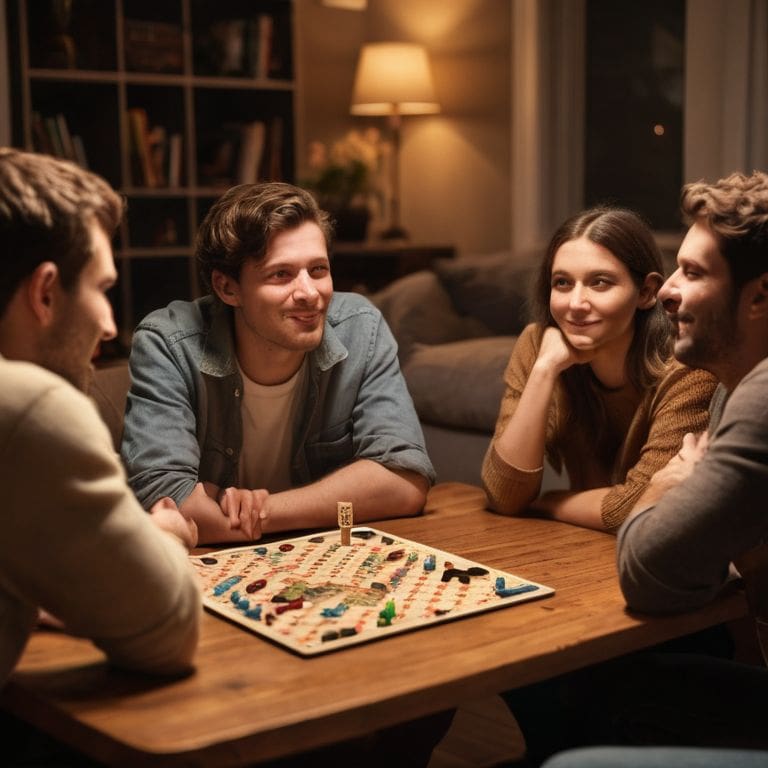I still remember the moment it hit me: how to be a better listener isn’t just about hearing the words, but about understanding the unspoken emotions and needs behind them. I was mediating an online dispute, and what struck me was how both parties felt unheard, despite being loud and clear about their points. It made me realize that effective listening is not just a skill, but a superpower that can diffuse tension and build bridges. As someone who’s passionate about helping people communicate better, I’ve seen firsthand how learning how to be a better listener can transform relationships and reduce stress.
In this article, I’ll share practical, no-nonsense advice on how to be a better listener, from tuning in to non-verbal cues to asking the right questions. You’ll learn how to create a safe space for open conversation, and how to navigate difficult topics with empathy and clarity. My goal is to provide you with actionable tools and real-life examples, so you can start improving your listening skills right away. By the end of this guide, you’ll be equipped with the skills to connect with others on a deeper level, and to build stronger, more meaningful relationships.
Table of Contents
Guide Overview: What You'll Need

Total Time: 1 hour to several days
Estimated Cost: $0 – $0
Difficulty Level: Intermediate
Tools Required
- Patience being open to new ideas and perspectives
- Attention focusing on the speaker without distractions
Supplies & Materials
- Notebook and Pen for taking notes during conversations
- Quiet Space a distraction-free area for focused listening
Step-by-Step Instructions
- 1. First, do this: create a safe space for open conversation by choosing a quiet, comfortable spot where both you and the other person feel relaxed and won’t be distracted. Consider the seating arrangement, the lighting, and even the temperature in the room to ensure it’s conducive to deep listening. I’ve found that when we set the right atmosphere, we’re more likely to connect with each other on a deeper level.
- 2. Next, give the speaker your undivided attention by putting away your phone, turning off the TV, and making eye contact. This simple act shows that you value and respect the other person, and it helps you stay present in the conversation. Remember, the goal is to understand the other person’s perspective, not to plan your response while they’re speaking.
- 3. Then, practice active listening by maintaining a non-judgmental and open-minded attitude. Avoid interrupting, even if you think you know what the other person is going to say, and try not to mentally prepare your response while they’re speaking. Instead, focus on the emotions and needs underlying their words, and show that you’re engaged by nodding, making supportive noises, or asking open-ended questions.
- 4. Now, learn to paraphrase and summarize what the other person has said to ensure you understand their perspective correctly. This doesn’t mean you have to agree with them, but rather that you’re making an effort to see things from their point of view. You can say something like, “Just to make sure I understand, you’re feeling frustrated because…” or “So, what you’re saying is…”. This helps prevent misunderstandings and shows that you’re actively listening.
- 5. As you continue to listen, pay attention to nonverbal cues, such as body language and tone of voice. These can convey just as much information as the words being spoken, and can often reveal underlying emotions or concerns that the other person may not be explicitly stating. If you notice a discrepancy between what’s being said and the nonverbal cues, you can gently ask for clarification to ensure you understand the situation correctly.
- 6. Next, use reflective listening to acknowledge the other person’s emotions and show that you’re empathizing with their experience. This can be as simple as saying, “I can see why you’d feel that way” or “That sounds really tough.” By validating their emotions, you create a safe space for the other person to open up and share their thoughts and feelings more freely.
- 7. Finally, follow up with open-ended questions to encourage the other person to share more about their thoughts, feelings, and experiences. Avoid leading questions or ones that can be answered with a simple “yes” or “no,” and instead opt for questions that encourage deeper reflection and exploration, such as “What was that like for you?” or “How did that experience shape your perspective?” By doing so, you can gain a richer understanding of the other person’s world and build a stronger, more meaningful connection with them.
How to Be a Better Listener

As I reflect on my experiences hosting board game nights, I’ve noticed that improving communication in relationships is crucial for a harmonious and enjoyable experience. One key aspect of this is being aware of nonverbal cues in conversation, such as body language and tone of voice. By paying attention to these subtle signals, we can better understand the emotions and needs of others, even when they’re not explicitly stated.
To create a safe space for open dialogue, it’s essential to overcome distractions while listening. This means putting away our phones, making eye contact, and avoiding interruptive thoughts. By doing so, we can focus on paraphrasing for understanding, which involves restating what the other person has said in our own words. This simple technique helps ensure that we’re on the same page and can prevent misunderstandings.
In my work as a relationship coach, I’ve seen how managing emotional responses while listening can be a game-changer. When we’re able to remain calm and composed, even in difficult conversations, we can respond more thoughtfully and avoid escalating conflicts. By cultivating this skill, we can create a more supportive and empathetic environment, where everyone feels heard and valued.
Beyond Distractions Improving Communication
To truly listen, we must first learn to silence the noise around us. This means putting away our devices, making eye contact, and being present in the moment. I’ve seen it time and time again at my board game nights – when we’re fully engaged, conversations flow effortlessly. By doing so, we create a safe space for open and honest communication.
In my experience as a relationship coach, I’ve found that distractions are often a symptom of deeper issues. By addressing the root cause of our distractions, we can improve our communication and build stronger connections with others.
Reading Nonverbal Cues for Deeper Understanding
When I’m hosting board game nights, I notice how people’s body language can reveal their true feelings. A crossed arm or avoided eye contact can speak volumes about their comfort level. Similarly, in our daily conversations, reading nonverbal cues can help us better understand the other person. By paying attention to these subtle signals, we can pick up on unspoken emotions and needs, allowing us to respond with more empathy and compassion.
I’ve found that recognizing these cues can be as simple as noticing a slight change in tone or a pause in speech. It’s about being present and fully engaged with the person in front of us. By doing so, we can create a safer and more supportive space for open communication, which is essential for building stronger, more meaningful relationships.
Tuning In: 5 Essential Tips to Become a Better Listener
- Practice active silence: allow the speaker to finish their thoughts without interrupting, and give them your undivided attention
- Use verbal and nonverbal cues: nod, make eye contact, and use phrases like ‘I see’ or ‘uh-huh’ to show you’re engaged and following along
- Paraphrase and summarize: repeat back what you’ve heard in your own words, to ensure understanding and show that you’re making an effort to grasp the speaker’s perspective
- Ask open-ended questions: encourage the speaker to share more by asking questions that begin with what, how, or why, rather than ones that can be answered with a simple yes or no
- Set aside distractions: turn off your phone, find a quiet space, and make a conscious effort to let go of your own thoughts and biases, so you can fully focus on the person speaking
Key Takeaways for Becoming a Better Listener
I’ve learned that actively tuning in to others can be a game-changer, allowing us to build stronger connections and navigate conflicts with more ease, all by cultivating the skill of deep listening
By recognizing and moving beyond distractions, we can improve communication and create a safe space for meaningful conversations to unfold, helping us to better understand each other’s needs and desires
Reading nonverbal cues, such as body language and tone of voice, can provide invaluable insights into the emotions and intentions of those around us, enabling us to respond with empathy and compassion, and ultimately fostering more harmonious relationships
The Heart of Connection
When we listen with the intention of understanding, rather than responding, we unlock the door to profound connections and meaningful relationships, where every conversation becomes an opportunity to bridge gaps and build bridges.
Mia Campbell
Embracing the Power of Deep Listening

As we’ve explored the art of listening, we’ve touched on several key points: moving beyond distractions to improve communication, and reading nonverbal cues for a deeper understanding of those around us. By implementing these strategies, we can become more empathetic and engaged listeners, fostering stronger, more meaningful relationships. It’s about creating a safe space for open dialogue, where everyone feels heard and valued. By doing so, we can break down barriers and build bridges of understanding, one conversation at a time.
As you continue on your journey to become a better listener, remember that it’s a skill that takes time and practice to develop. Don’t be too hard on yourself when you slip up – instead, focus on progress, not perfection. With patience, dedication, and a willingness to learn, you can transform your relationships and unlock a more compassionate, empathetic you. So, take a deep breath, tune in, and let the beauty of deep listening enrich your life and the lives of those around you.
Frequently Asked Questions
How can I ensure I'm not just hearing words, but truly understanding the emotions and needs behind them?
To truly understand the emotions and needs behind someone’s words, I recommend practicing empathetic reflection. This means paraphrasing what you’ve heard and asking open-ended questions to clarify their feelings and needs. For example, you could say, “Just to make sure I understand, can you help me see what’s driving your concern?” or “How did that experience make you feel?
What if the person I'm listening to is speaking in a way that's hard for me to understand, whether due to accent, terminology, or pace?
I totally get it – sometimes we struggle to understand the person speaking due to accent, terminology, or pace. In those moments, I recommend asking gentle clarifying questions, like “Can you repeat that?” or “How did you mean that?” This shows you’re engaged and care about understanding them, rather than simply giving up.
Can being a better listener ever be taken too far, where I prioritize others' needs over my own and compromise my own emotional well-being?
I’ve seen this dilemma play out in my own coaching practice – when we prioritize others’ needs over our own, we risk emotional burnout. It’s essential to strike a balance between active listening and self-care, recognizing that our own needs are just as vital as those we’re listening to.
